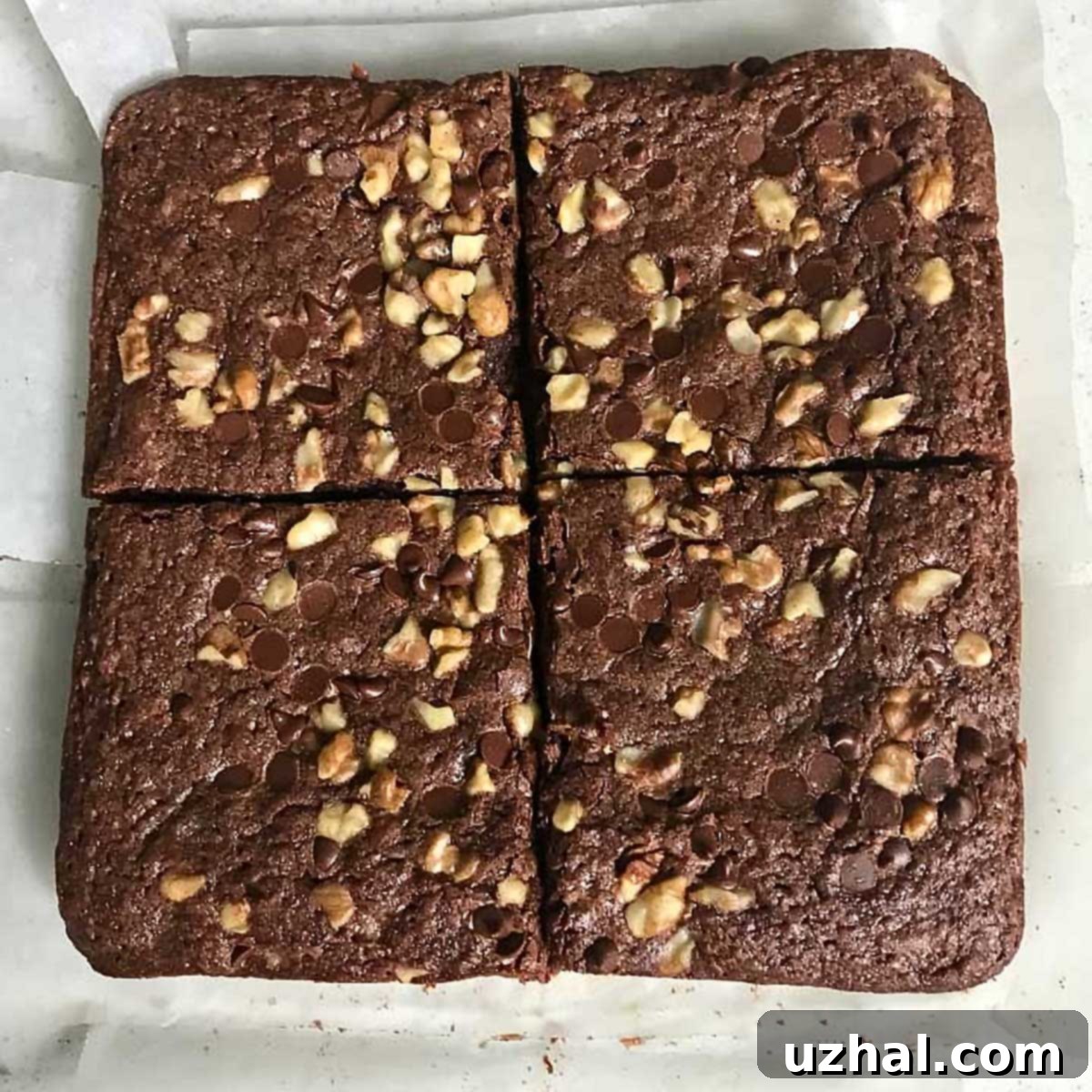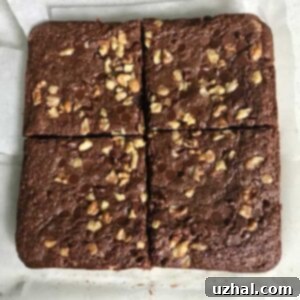Easy Cake Flour Brownies: Achieve Fudgy Perfection with This Simple Recipe
Brownies are a timeless American dessert, cherished for their rich chocolate flavor and irresistible texture. These Easy Cake Flour Brownies epitomize everything a great brownie should be: wonderfully fudgy, simple to prepare, and requiring minimal ingredients. While this recipe specifically uses cake flour, don’t let the name mislead you – these are far from “cakey.” Instead, they strike a perfect balance, offering a delightful chewiness and deep chocolate experience without being overly dense or excessively fudgy like some of their counterparts. In fact, they bear a close resemblance to the classic Lowney’s Brownies, providing a nostalgic taste with a modern twist.

The Sweet Origin: Who Invented Brownies?
The history of the chocolate brownie is as rich and captivating as the dessert itself, with its roots firmly planted in late 19th-century America. It’s widely believed that this beloved treat was first conceived by innovative chefs at The Palmer House Hilton in Chicago. The story goes that Bertha Palmer, a prominent socialite, desired a unique dessert for the Women’s Pavilion at the 1893 World’s Columbian Exposition. She specifically requested “a cake-like confection, smaller than a piece of cake, that could be easily eaten from a boxed lunch.” Pastry chef Joseph Sehl rose to the challenge, creating a distinctive chocolate square topped with walnuts and an apricot glaze. These original Palmer House brownies were notably fudgier and richer than many later versions, setting a high standard for future brownie creations.
Chocolate Brownies Through the 20th Century: An Evolution
While the Palmer House brownies marked the beginning, the dessert’s popularity truly soared in the 20th century, leading to countless variations and new narratives about its origin. Food historians, including Jean Anderson in her “American Century Cookbook,” have explored the evolution of brownies. Anderson’s research, focusing on recipes and stories from the 1900s onwards, highlights various amusing theories: a lady in Bangor, Maine, supposedly “ruined” a cake and called it “brownies”; some suggested they were Americanized versions of Scottish cocoa scones; and another tale attributed their invention to a woman simply named “Brownie.”
However, factual evidence points to the earliest published brownie recipes appearing around 1906. Two significant publications introduced the world to brownies: the updated edition of Fanny Farmer’s “The Boston Cooking School Cookbook” and the Lowney’s Cookbook, published by the Walter M. Lowney Company, a well-known chocolate manufacturer. These early recipes played a crucial role in popularizing brownies across American households, cementing their status as a national favorite.
A Glimpse into the Past: Early Lowney’s Brownies Ingredients
Among the various early brownie recipes, the Lowney’s version is often cited as one of the most influential originals. Its ingredient list was surprisingly straightforward, emphasizing the quality of a few key components. Here’s what a typical early Lowney’s recipe called for:
- 4 oz butter (114 grams)
- 1 cup sugar (200 grams)
- 2 oz unsweetened chocolate (56 grams)
- 2 eggs
- ½ cup all-purpose flour (65 grams)
- ¼ teaspoon salt
- ½ cup nut meats (often walnuts or pecans)
This minimalist approach highlights the essential elements of a classic brownie: rich butter, intense chocolate, and a touch of sweetness, with nuts providing a welcome textural contrast. The simplicity of these ingredients allowed the deep chocolate flavor to truly shine.
Mastering the Modern Classic: Easy Cake Flour Brownies
Our Easy Cake Flour Brownies recipe builds upon the heritage of those early originals, introducing a slight modification that profoundly impacts texture: the use of cake flour. While traditional recipes often call for all-purpose flour, switching to cake flour, coupled with a hint of baking powder, creates a brownie that is incredibly soft, tender, and distinctly fudgy, without becoming “cakey” or dry. This thoughtful adaptation results in a brownie that melts in your mouth, offering a superior eating experience.
For those seeking delicious, reliable brownies without fuss, this recipe is an absolute winner. It’s perfect for everyday baking, impromptu dessert cravings, or whenever you need a dependable crowd-pleaser. The combination of easy steps and exceptional results makes these a go-to for any home baker.
The Power of Two Ounces: Unsweetened Baking Chocolate
At first glance, using only 2 ounces (56 grams) of unsweetened chocolate might seem insufficient for a truly decadent brownie. However, when balanced with the modest amounts of other ingredients in this recipe, this small quantity of high-quality unsweetened chocolate delivers a remarkably potent and deep cocoa flavor. The intensity of the chocolate is not diluted, allowing its complex notes to come through beautifully. This precise measurement ensures a rich, dark chocolate profile that is characteristic of classic fudgy brownies.
Because the amount is relatively small, this recipe offers a fantastic opportunity to indulge in your favorite high-end baking chocolate. Using a premium unsweetened bar can significantly elevate the overall taste of your brownies. I personally love using Ghirardelli’s 100% cacao baking chocolate for its robust flavor, but feel free to experiment with any brand you trust for superior chocolate confections. The quality of your chocolate directly translates into the richness of your final product.
Why Cake Flour Makes a Difference in Brownies
Many traditional brownie recipes rely on all-purpose flour, and they can be delicious. However, opting for cake flour brings a subtle yet significant improvement to the texture of your brownies. Cake flour has a lower protein content (around 7-9%) compared to all-purpose flour (10-12%). Less protein means less gluten development. In baked goods like cakes, this results in a finer, more tender crumb. For brownies, it translates to a softer, more delicate texture that enhances their fudginess without making them crumbly or overly dense. It helps create that desirable melt-in-your-mouth quality that distinguishes truly great brownies.
The addition of a small amount of baking powder in this recipe further refines the texture. While you might associate baking powder with “cakey” results, here it’s used sparingly to provide just enough lift to prevent the brownies from being too heavy, ensuring they remain soft and moist, rather than dense or brick-like. This combination of low-protein flour and a touch of leavening creates a brownie that is perfectly balanced in both chewiness and tenderness.
Tips for Baking Perfect Fudgy Brownies
Achieving the perfect fudgy brownie is a delightful endeavor. Here are some essential tips to ensure your cake flour brownies turn out perfectly every time:
- Quality Ingredients Matter: As mentioned, use good quality unsweetened chocolate. Fresh eggs and real vanilla extract also make a noticeable difference in flavor.
- Don’t Overmix: After adding the dry ingredients to the wet, mix just until combined. Overmixing develops gluten, which can lead to tougher, more cake-like brownies. A few streaks of flour are fine; they’ll disappear during baking.
- Proper Pan Preparation: Lining your 8-inch pan with foil or parchment paper and spraying it ensures easy removal and clean cuts. Leave an overhang on the sides for “handles.”
- Watch the Baking Time: Brownies can go from fudgy to dry very quickly. Start checking for doneness a few minutes before the recommended bake time. A toothpick inserted into the center should come out with moist crumbs, not wet batter, and certainly not completely clean. The edges should be set, and the center might still look slightly underbaked (it will continue to cook as it cools).
- Cool Completely: This is crucial for fudgy brownies. Allowing them to cool to room temperature (or even chilling them) allows them to set properly, enhancing their dense, fudgy texture. Cutting warm brownies often results in a crumbly mess.
- Toasted Nuts for Flavor: If you’re adding nuts, toast them lightly before incorporating them into the batter. This simple step brings out their natural flavor and adds an extra layer of deliciousness.
Serving and Storing Your Delicious Brownies
Once your Easy Cake Flour Brownies have cooled and are ready to be devoured, the possibilities are endless. They are fantastic on their own, perhaps with a tall glass of cold milk or a hot cup of coffee. For an indulgent treat, serve them warm with a scoop of vanilla bean ice cream, a drizzle of chocolate sauce, or a dollop of whipped cream. A sprinkle of sea salt on top before serving can also enhance the chocolate flavor beautifully.
To store leftover brownies, place them in an airtight container at room temperature for up to 3-4 days. For longer storage, you can freeze them for up to 2-3 months. Wrap individual brownies tightly in plastic wrap, then place them in a freezer-safe bag or container. Thaw at room temperature before enjoying.
- Frosted Fudge Brownies
- Guittard Truffle Brownies
- Gourmet Deep Dark Chocolate Brownies
- Chocolate Brownie Cookies
- Double Chocolate Chip Brownies
Recipe

Easy Cake Flour Brownies
Pin Recipe
Ingredients
- 1 stick unsalted butter (114 grams)
- 2 oz good quality unsweetened chocolate (56 grams)
- 1 cup granulated sugar (200 grams)
- 2 large eggs (110 grams)
- 1 teaspoon vanilla
- ⅔ cup cake flour (80 grams)
- ½ teaspoon baking powder
- ¼ teaspoon salt
- ½ cup toasted nuts optional
- ¼ cup mini chocolate chips optional
Instructions
-
Preheat oven to 350 degrees F (175°C). Line an 8-inch metal pan with foil, ensuring there’s an overhang on the sides for easy lifting. Spray the bottom only with cooking spray to prevent sticking. Alternatively, parchment paper can be used.
-
In a small saucepan, melt the butter over medium heat. Once melted, reduce the heat to low, add the unsweetened chocolate, and stir briefly for about 15-20 seconds. Immediately turn off the heat and continue stirring until the chocolate is fully melted and smooth from the residual heat. Let this mixture cool for about 10 minutes to prevent cooking the eggs in the next step.
-
Add the granulated sugar to the slightly cooled chocolate mixture and stir vigorously until well combined. Then, add the eggs one by one, whisking or stirring thoroughly after each addition until fully blended and the mixture is glossy. Finally, whisk in the vanilla extract for added flavor.
-
In a separate bowl, combine the cake flour, baking powder, and salt. Gradually add this dry mixture to the chocolate batter, stirring gently until just blended. Be careful not to overmix. If you’re including nuts, fold them in at this stage.
-
Pour the brownie batter into your prepared 8-inch pan. If desired, sprinkle mini chocolate chips and any additional nuts over the top for extra texture and chocolate goodness. Bake on the center rack of your preheated oven for approximately 20 minutes. Brownies are done when they start to smell fragrant and the edges appear set, with the center still looking slightly soft. They will puff up slightly during baking and then settle as they cool.
-
Allow the brownies to cool completely to room temperature in the pan. For a quicker cool-down, you can set the pan in a larger pan filled with ice water, ensuring no water gets into the brownie batter. Once fully cooled, use the foil overhangs to carefully lift the brownies out of the pan. Cut into your desired size squares or rectangles and enjoy!
